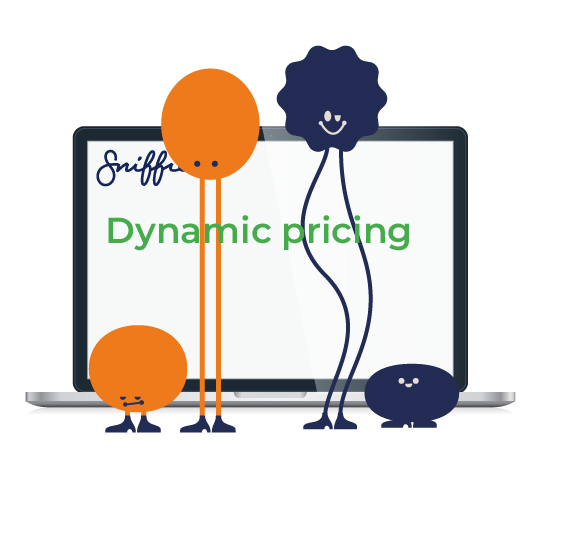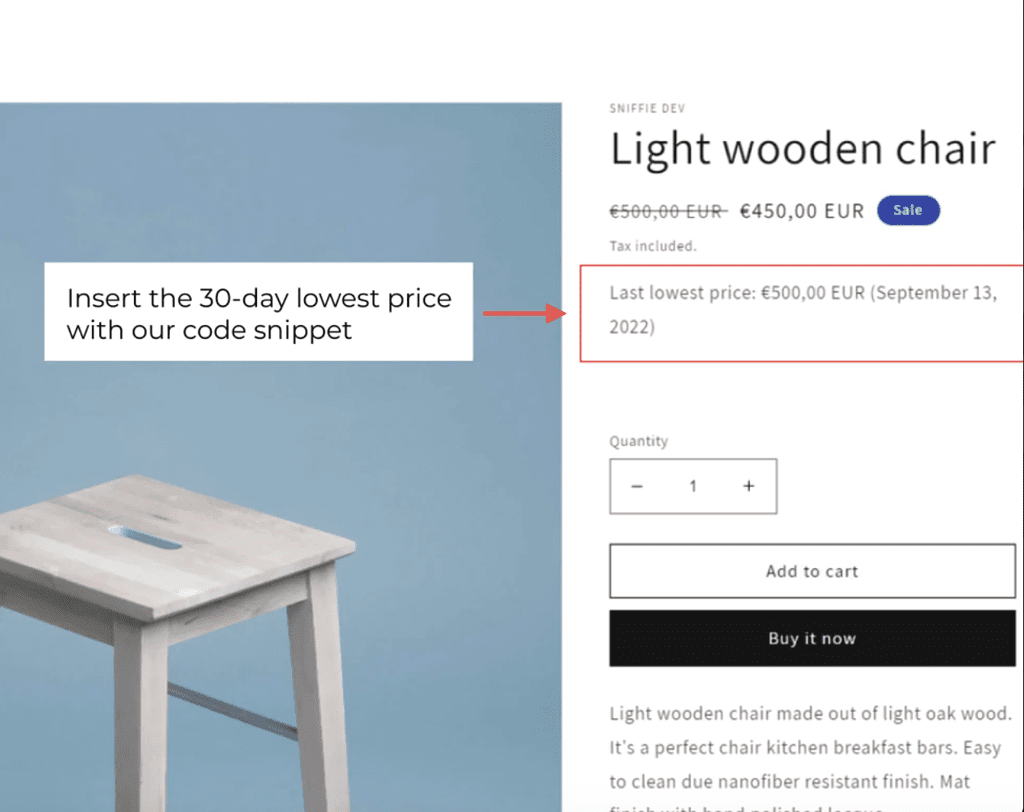As the ecommerce industry continues to grow and evolve, businesses need to stay up-to-date with the latest trends in the environment to remain competitive and maximise profits. Several current trends may impact how you price your goods and services. Hence it is essential to have a broad understanding of the environment and where it is heading to avoid falling behind.
We’ve compiled a list below of the top ecommerce trends to be on the lookout for in 2023 as we begin the new year. We go over each trend and what it means for e-commerce pricing in the sections that follow.
2023 eCommerce trends:
Increased use of mobile
Mobile commerce accounted for approximately two-thirds (65.7%) of all worldwide e-commerce retail transactions as of January 2022 (Statista), a trend that will keep on growing. Indeed, online shopping is now easy and accessible from all sorts of tablets, phones, and computers. This means that to stay competitive in the market, e-commerce businesses need to be mindful of their mobile sales and ensure that their platforms (whether it is a website or an app) are mobile-friendly.
Mobile commerce may also have an impact on pricing. Here are a few examples:
- Personalisation: the use of mobile enables retailers to personalise prices based on customer data, for instance, the location, browsing behaviour, purchase history, abandoned checkout cart, and more. This allows retailers to offer personalised discounts, which in turn helps increase sales and customer loyalty.
- Comparison shopping: mobile devices make it easier for consumers to compare prices and make sure they are getting the best deal on the market. Retailers need to ensure they have their prices set right at any given moment to attract new and existing customers.
- Dynamic pricing: factors such as comparison shopping and personalisation increase the use of dynamic pricing systems. Retailers can optimise their pricing strategies according to factors such as supply and demand, competition and consumer behaviour to increase profits.
- Mobile-exclusive deals: some businesses may offer mobile-exclusive deals or promotions in order to encourage mobile purchases. This can also help drive traffic to their mobile app or website.
Overall, mobile commerce can have a significant impact on pricing strategies and retailers need to consider how they can use mobile technology to optimise their pricing.
Various new ways to pay
With the increased use of mobile comes also different ways to pay. The use of digital wallets such as PayPal, Apple Pay, Google Pay and Square is ultimately increasing, and customers can choose between various payment methods at different moments.
The introduction of new payment methods in e-commerce can affect pricing in several ways:
- Fees: some payment options may incur transaction fees, which may increase the overall cost of a purchase. For example, PayPal charges a fee for its services, which is typically passed on to the consumer.
- Conversion rates: if a business accepts multiple payment methods, it may need to consider conversion rates when setting prices. For example, if a business accepts both USD and EUR, it may need to consider the exchange rate when setting prices in order to ensure that it is making a profit. This is increasingly important due to the globalisation of e-commerce.
- Competition: the introduction of new payment methods can also impact pricing due to competition. For example, if a competitor begins accepting a new payment method that is popular with consumers, a business may need to consider offering that payment method to remain competitive.
To summarise, the introduction and growing number of new payment methods in ecommerce can have a great impact on pricing. Retailers must consider these various factors when setting their online prices to ensure optimised pricing and to remain competitive.
Personalisation
As already mentioned earlier in this post, personalisation is a growing trend and an important one in the eyes of the consumer. With growing abilities to collect and use customer data through machine learning, retailers can tailor products and services to fit the individual preferences of a customer. This can involve offering different prices to different customers based on various factors such as location, purchase history, and demographic data.
Personalisation can affect retailers’ pricing strategies in a few ways:
- Personalised discounts and promotions: personalisation can allow retailers to offer customised discounts and promotions based on a customer’s past purchases, browsing history, and other data. This can help drive sales and increase customer loyalty.
- Increased value: personalisation can also help increase the perceived value of a product or service. Customers may be willing to pay more for a product or service that is tailored to their needs and preferences. Some businesses are shifting away from cost-based pricing and instead using value-based pricing, where the price is based on the perceived value of the product or service to the customer. This can involve offering premium pricing for high-quality products or services, or charging a lower price for less differentiated products. Value-based pricing can help businesses differentiate their products and command higher prices, allowing them to focus on the value they provide to customers rather than simply trying to compete on price.
- Dynamic pricing: Personalisation can also be used in conjunction with dynamic pricing, which involves adjusting prices based on factors such as supply and demand, competition, and consumer behaviour. For example, a retailer may offer a higher price to a customer who has shown a strong preference for a particular product, while offering a lower price to a less interested customer.
Overall, personalisation allows retailers to optimise prices based on individual customer data and preferences and can help increase sales and customer loyalty. However, retailers need to balance the benefits of personalisation with the need to remain competitive and offer fair prices.
Social media commerce
Social media ecommerce refers to the use of social media platforms, such as TikTok, Instagram, and Pinterest, for online shopping. This can be achieved through features such as shoppable posts, in-app purchases, and buy buttons.
Social media ecommerce influences pricing in several ways:
- Competition: The use of social media for e-commerce can increase competition among businesses, as it allows more companies to reach a wider audience. This can put pressure on businesses to offer competitive prices to attract and retain customers.
- Personalisation: Social media platforms can also be used to personalise prices based on individual customer data. This can allow businesses to offer personalized discounts and promotions, which can help increase sales and customer loyalty.
- Customer ratings: Social media e-commerce platforms often include customer reviews and ratings, which can impact a customer’s purchasing decision and potentially affect pricing. For example, a product with high ratings may be higher priced.
Social media ecommerce can increase competition and the ability to personalise and dynamically price products and can be influenced by customer reviews and ratings. Businesses need to consider these factors when setting prices to optimise their pricing strategies.
Delivery options
With the increased use of ecommerce globally, comes various delivery options that retailers use to attract consumers. Some new delivery trends that have been growing in the e-commerce industry in recent years include; same-day delivery, contactless delivery, drone delivery and green delivery.
These various delivery options can affect a business’ pricing in several ways. For instance, while same-day delivery may be convenient, it may involve additional fees that are passed on to the customer. Green delivery may involve additional costs for the retailer, as it aims to reduce the number of unnecessary deliveries and increase the use of electric vehicles. This may be passed on to the customer in the form of higher-priced products.
It is important for businesses to consider the costs and benefits of different delivery options and how they may impact pricing, and remember these when calculating costs.
Use Our Free Price Elasticity Calculator
Use this simple calculator to calculate your product’s price elasticity and understand how price changes affect your product’s demand.

Increased use of AI
Artificial intelligence (AI) is the ability of machines to perform tasks that would normally require human intelligence, such as learning, problem-solving, and decision-making. AI is being increasingly used in the ecommerce industry to improve various aspects of the online shopping experience, including personalisation, product recommendations, and automation of various tasks.
Here are a few ways in which the use of AI in ecommerce can be used in pricing:
- Dynamic pricing: AI can be used in conjunction with dynamic pricing. AI can help retailers more easily implement dynamic pricing strategies by analysing large amounts of data in real-time and making adjustments as needed. Many companies use AI pricing software, such as Sniffie, to optimise their prices.
- Increased efficiency: AI can help increase the efficiency of various tasks, such as inventory management and order fulfilment. This can help reduce costs for retailers, which may allow them to offer lower prices to customers.
- Competition: The use of AI in e-commerce can also increase competition, as it allows more businesses to access advanced technologies and improve their operations. This can put pressure on businesses to offer competitive prices in order to attract and retain customers.
Inflation as an important issue
Inflation is the sustained increase in the general price level of goods and services in an economy over a period of time. It is typically measured by the percentage change in a price index, such as the consumer price index (CPI). Inflation can have a significant impact on e-commerce pricing, and as it has been rising, it is an important factor to consider in 2023.
Here are a few ways in which inflation can affect pricing:
- Prices: Inflation can cause the prices of goods and services to increase over time. This can impact the prices of products sold through ecommerce platforms, as retailers may need to adjust their prices to keep up with inflation.
- Margins: Inflation can also impact a business’s profit margins, as the cost of goods and services may increase, while the price of the products being sold may not. This can make it more challenging for retailers to maintain healthy profit margins, which may affect their pricing strategies.
- Purchasing power: Inflation can reduce the purchasing power of consumers, as their money may not be able to buy as much as it did before due to rising prices. This can affect the demand for online goods and services.
- Competition: Inflation can also impact competition in the e-commerce industry, as businesses may need to adjust their prices in order to remain competitive and meet the needs of their customers.
It is important for businesses to carefully consider the effects of inflation on their operations and pricing strategies.
Use our sale price planning tool
Are you interested to know what is the best price for your next discount campaign? Is raising the price before the campaign wise? To know it, try out our latest tool Discount Campaign Pricing Simulator and play with two scenarios and real-life demand.

Subscription models
Subscription models are a type of pricing strategy in which customers pay a recurring fee for access to a product or service. This can be an attractive option for both businesses and customers, as it can provide a predictable source of revenue for businesses and a convenient and cost-effective way for customers to access products or services.
Subscription models can have a variety of impacts on ecommerce pricing:
- Customer loyalty: Subscription models can help increase customer loyalty, as customers are more likely to continue using a product or service if they are paying a recurring fee for it. This can help businesses retain customers and increase revenue over time.
- Price elasticity: Subscription models can also affect the price elasticity of a product or service. Price elasticity refers to the degree to which the demand for a product or service is sensitive to changes in price. Subscription models may be less sensitive to price changes, as customers are paying a recurring fee rather than a one-time purchase price.
- Competition: Subscription models can also impact competition in the ecommerce industry, as businesses may need to offer competitive pricing and value in order to attract and retain subscribers.
- Customer segmentation: Subscription models can also allow companies to segment their customer base and offer different pricing tiers based on the level of access or features that customers are paying for. This can help businesses optimise their pricing strategies and meet the needs of different customer segments.
Especially for retailers selling common products, it may be a smart idea to think about using a subscription model.
Transparency & sustainability
Many consumers are becoming more price-sensitive and are looking for greater transparency in pricing. Businesses that are upfront and transparent about their pricing may be more appealing to these customers. This can involve clearly displaying prices on websites and other channels, as well as being transparent about any fees or charges that may be involved in the purchase process. Actually, the new EU Omnibus Directive is set out to make sure that business comply with transparency.
In addition, consumers are increasingly seeking sustainability in the products and services they purchase. This can affect the demand for certain products and services, which can in turn impact pricing. For example, a product that is perceived as more transparent and sustainable may command a higher price.
Sustainability can also impact the cost of production for businesses, as sustainable practices may involve additional expenses, such as the use of environmentally-friendly materials or processes. This can affect the overall cost of goods and services, which can impact in turn pricing.
Transparency and sustainability can also impact a business’s brand reputation and customer loyalty. Consumers may be more likely to purchase from a business that is perceived as transparent and sustainable, which can help drive sales and increase revenue.
Overall, transparency and sustainability can have a variety of impacts on e-commerce pricing. In order to satisfy customer expectations and maximise their pricing strategies, it is crucial for firms to take these aspects into account when setting prices.
Ensuring Price Display Compliance
Make sure to adhere to the Omnibus Directive when reducing the price of your products.

Conclusion
As this list of trends shows, multiple aspects in the environment may affect pricing strategies and pricing decisions. It is crucial to keep up with current trends in order to make the best possible pricing decisions and optimise profits. By regularly reviewing and adjusting their pricing strategies, businesses can ensure that they are aligned with their goals and the needs of their customers.
Finally, the complexities of the environment with the use of various data from omni-channel platforms is making it more difficult for companies to organise and predict their pricing strategies. Hence, the use of well-set systems, such as pricing software and pricing management systems is becoming a must in order to survive as an ecommerce store.
We hope this list gives you a better overall view of the pricing environment for this year.
Use our FREE tools from Resource Library
Are you interested to know what is the best price for your next discount campaign? Is raising the price before the campaign wise? To know it, try out our latest tool Discount Campaign Pricing Simulator and play with two scenarios and real-life demand.



